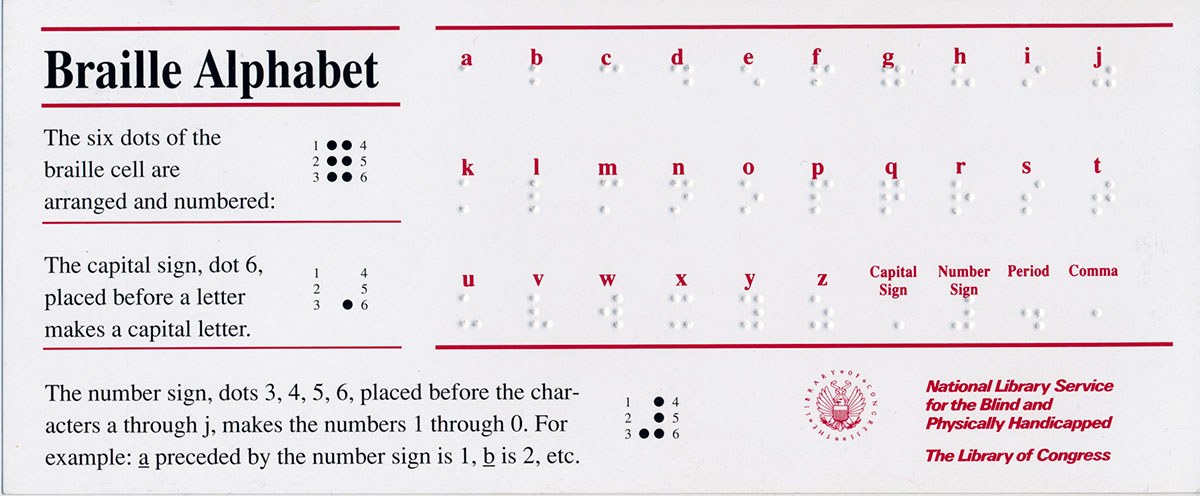
The Braille Alphabet courtesy of the National Library Service for the Blind and Physically Handicapped.
EL PASO – Trying to pick from the vast number of dishes on a restaurant menu can be challenging, but imagine not being able to see the menu. Blind or vision-impaired persons must deal with that anomaly.
Only a few restaurants in El Paso offer braille menus to their blind or vision-impaired customers, according to phone interviews with 21 local restaurants. The only ones were the national chains Red Lobster, Olive Garden, Applebee’s, and BJ’s Restaurant & Brewhouse.
Some 21 million adults – about 9 percent of the U.S. population over the age of 18, reported having vision problems, according to the 2011 National Health Interview Survey prepared by the National Center for Disease Control and Prevention.
Braille is one form of text the vision-impaired can read. According to Richard Dugan, coordinator of the Assistive Technology Lab of The University of Texas at El Paso, two types of braille are used – “baby” braille, which transcribes text letter for letter and the more commonly known grade 2 braille.
“Most braille documents in grade 2 braille are going to have a number of contractions in them or they will drop certain letters…” to shorten the braille text, said Dugan.
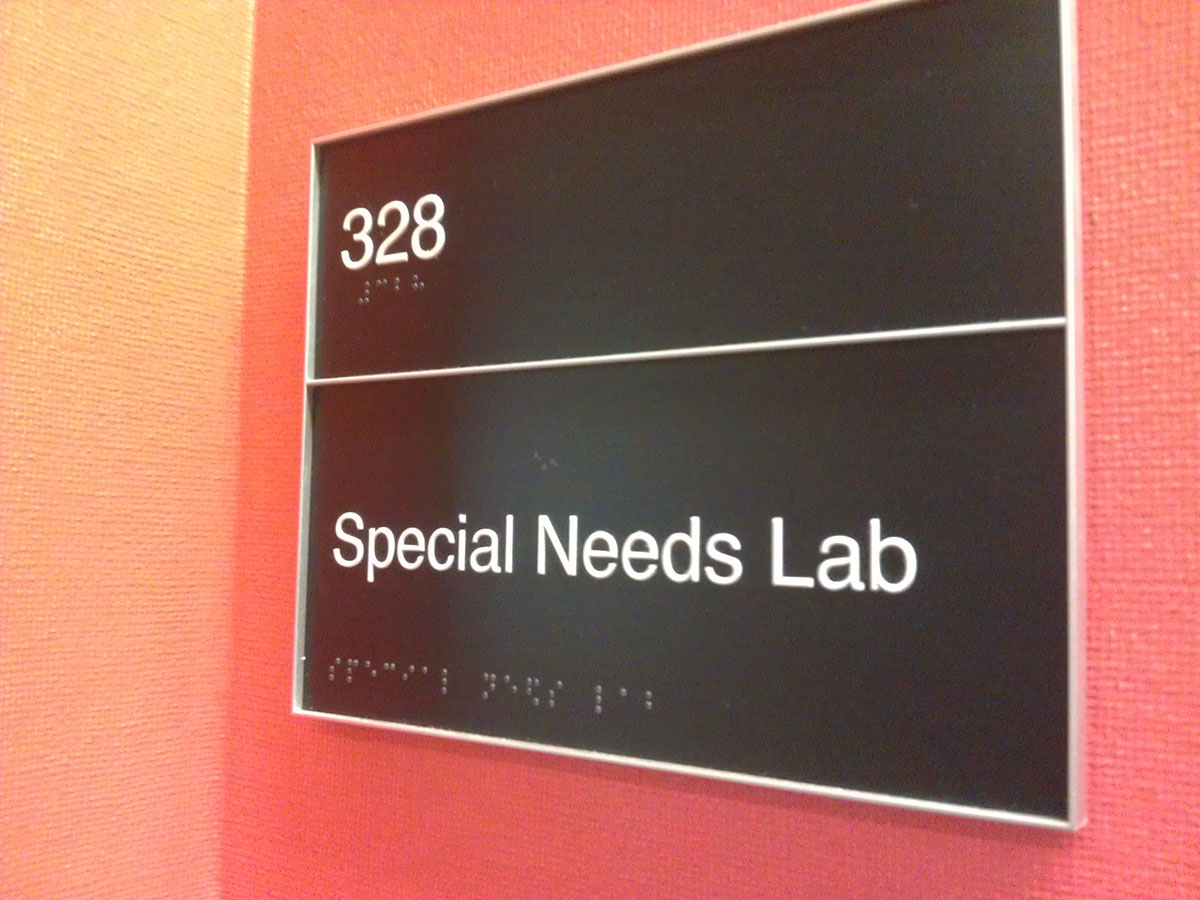
The Assistive Technology Lab on the second floor of the UTEP library. (Sarah Duenas/Borderzine.com)
The lab is a service offered by the Center for Accommodations and Student Services (CASS), formerly known as the Disabled Student Services Office.
“Students feel less stigmatized [after the name change] and they can come and get services. They are not being stigmatized and we are not labeling them,” said Neelam Agarwal, Ed. D., assistant director for CASS. “We have more than 500 students right now registered with our office. We serve all kinds of students with all kind of disabilities.”
The lab, in room 329 on the third floor of the library, offers a vast amount of services to vision-impaired students and staff, including braille translation software.
“The student can come in scan in their page and they save it as a braille file and you can send it to the braille printer an embosser that punches out the raised dots for braille,” Dugans states. “We have had professors come in here to put things into braille for their students. We also have a program that we are running called dancing dots for musical Braille.”
They also offer the screen-reading software JAWS and Dragon Naturally Speaking, and Zoom Text that magnifies letters on the computer screen, and a close-circuit TV that magnifies hard copy text.
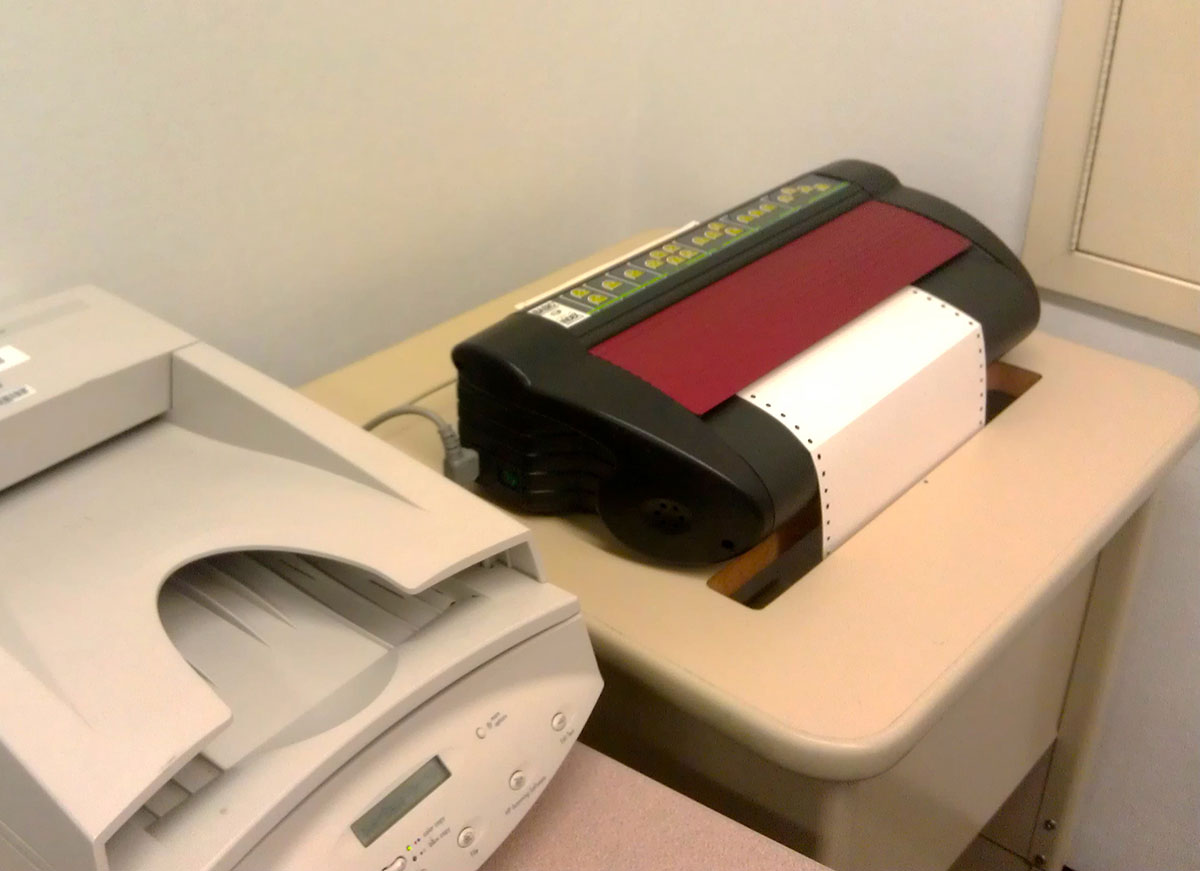
Students and teachers can have text converted to braille at the lab using a braille embosser (Sara Duenas/Borderzine.com)
“We can address the needs of the students who are completely blind,” said Dugan. “As well as the students who have low vision.”
Agarwal said their main goal is to, “…provide academic accommodations to students with disabilities so that they can study like all of the students on campus. Main purpose is to provide equal access, equal participation, with the help of Accommodations we are leveling the playing field for them so that they can study like all of the students.”
CASS is not the only location on campus that is aiming at making accommodations for those students who are blind or vision impaired. Adriana Ruiz, District Marketing Manager for Food services by Sodexho explained what her department help blind or vision impaired students. She said that blind students often come with another person to assist them in ordering food.
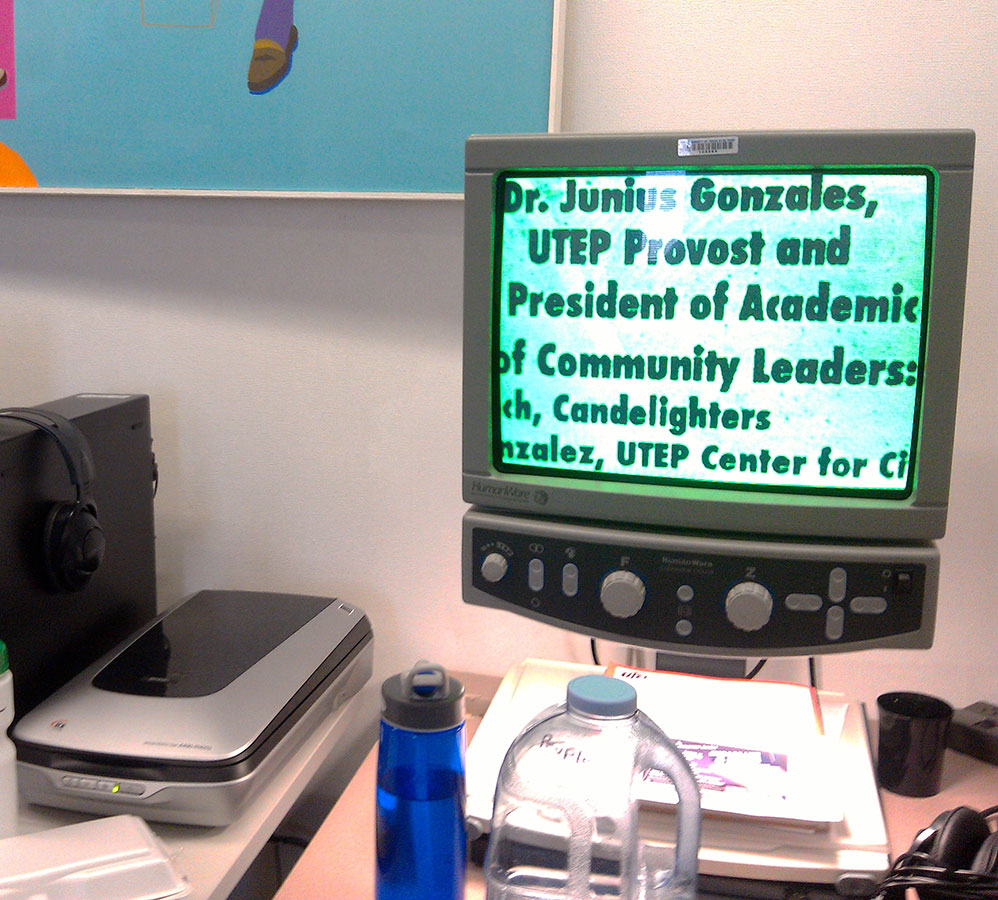
A close circuit television located inside the Assistive Technology lab is used to magnify hard copy text. (Sarah Duenas/Borderzine.com)
“They’ll let them know what we have and what not. A lot of times, they’ll sample. Like at Mein Bowl for example the spicy chicken they want to know if it’s too spicy whether or not to get the full entrée or not,” Ruiz said.
Ruiz also mentions that the employees of the restaurants on campus offer assistance to the blind or visually impaired.
“A lot of times our cashiers they’ll help kind of count money and talk to them and they have their own ways of knowing how much money is in their pockets,” Ruiz said.
The use of braille menus at restaurant locations on campus has never been brought up to Food Services before, according to Ruiz. “All comments and concerns are always more than welcome,” she said. “I never really considered or thought about braille menus it’s the first time that it comes up. So it’s definitely something for us to explore and another way of accommodating all of our customers and the students here.”
Wanda Morgan, a Mein Bowl employee at the Student Union location said: “They get around real well and they usually get Sushi. I don’t know how they pick it out but they do and then they come here. They are pretty self-sufficient.”
The employees at the various restaurant locations on campus do their best to accommodate blind or vision impaired students.
“When they come, we just try to accommodate them and make things as simple as we can. I usually ask them if they need help going to a table or something. We try to be friendly to everybody,” Morgan said.
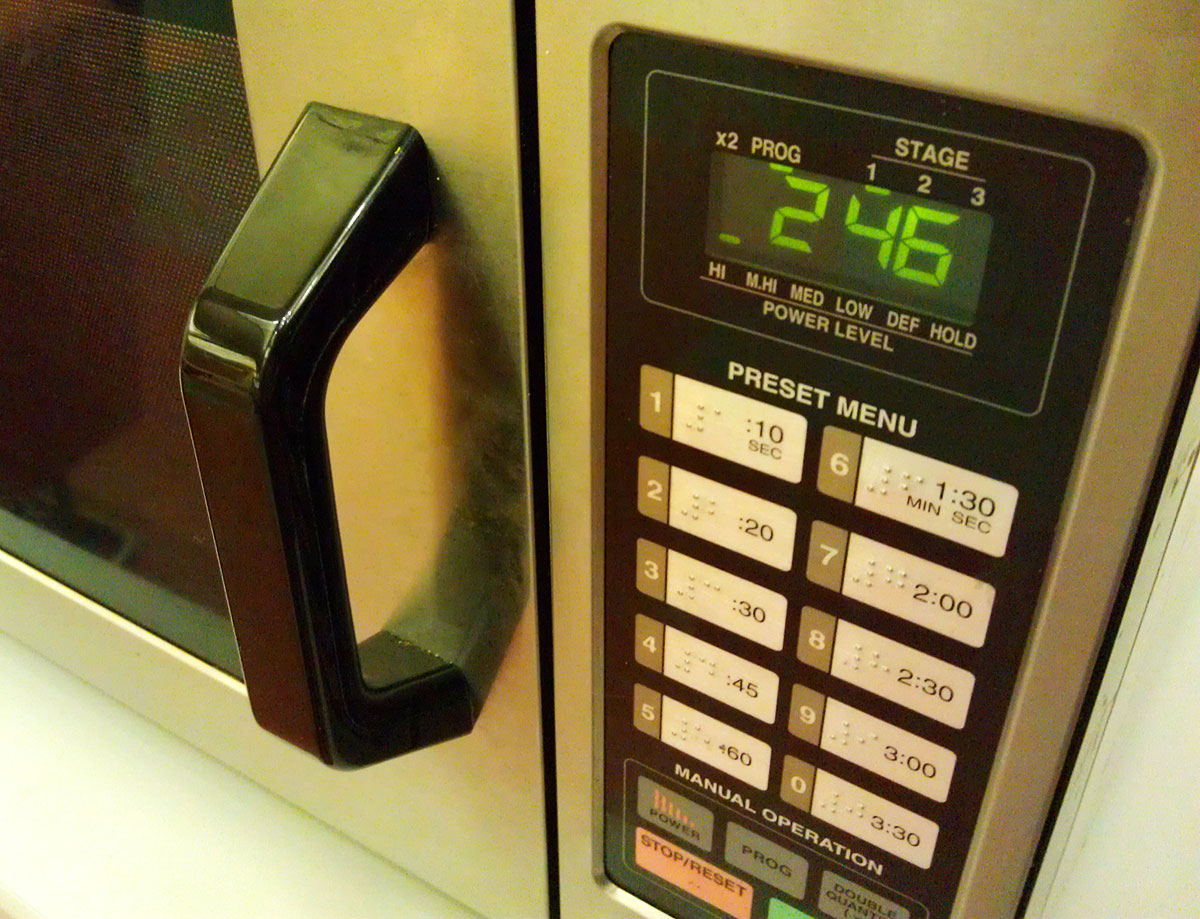
A microwave located inside the UTEP Union East with braille is one of the services that Sodexo offers to the visual impaired. (Sarah Duenas/Borderzine.com)
Although Food Services do not offer Braille menus at their various locations, they do have several microwaves with braille buttons located inside UTEP’s Union East.
Braille Works, an organization based out of Seffner, Fla. that provides assistive technology materials for the blind and visually impaired, some alternative formats are braille and large print documents, and audio transcription. Their mission is about “Making The World A More Readable Place ™.”
Jeff Frcho, Marketing and Social Media Coordinator for Braille Works, said the company has “a lot of restaurant clients where we do restaurant menus; we work with financial institutions to transcribe financial statements for people; we work with transportation companies (for) bus schedules and bus routes for people who are blind, just about anything you can think of.”
Among the more nationally known restaurants that offer braille menus for those customers who require them are Applebee’s, Olive Garden, Red Lobster, and Outback Steakhouse. “That is how the company really got its feet off the ground back in 1994,” said Frcho. “When the company started we dove right into the restaurant menu market and we have been working with a lot of nationally recognized chains.”
Braille or large print menus can have a positive impact on both the customer and the restaurant establishment. Not only does it give the customer a sense of independence but it also shows that the restaurant is meeting the needs of all their customers.
He said his company wants the visually impaired to “be able to come in and have a dining experience just like anybody else would have. They don’t have to sit there and feel embarrassed by having the waiter read the menu to them.”
For El Paso resident and Lighthouse for the Blind employee Rocio Rodriguez this is quite true. She learned how to read braille when she completely lost her sight in 1984 from glaucoma. She said that braille menus in restaurants give her that sense of independence.
“I don’t have to depend on somebody to read the menu to me.”
Rodriquez believes more restaurants should offer braille menus.
Currently there is no law requiring restaurants to provide Braille menus to visually impaired customers. “It’s just a way for companies to show that they care and also avoid potential litigation against their company for not supplying it,” Frcho said.
According to the Department of Justice, the American with Disabilities Act provides protection and civil rights to those individuals who have disabilities. There is currently a tax incentive for businesses that make their business more accessible to people with disabilities.
UTEP student Oscar Lozoya was born with retinitis pigmentosa and had vision problems as a young child. Around ten years ago, he began losing his vision more rapidly. Lozoya is currently working on his third master’s degree in rehabilitation counseling. He also has a BA in Music, a MFA in creative writing, and an MFA in anthropology. Lozoya learned how to read Braille around five years ago. He said that the use of Braille menus was a good thing for him because they made him feel included.
“They (Braille menus) definitely should be very useful for many people. Maybe I don’t use them because I don’t go to restaurants alone. I always go with someone else. For me it is faster and more fun than to read it by myself. But, for other people they may be very useful because this tool might give them independence and autonomy and might make them feel that they can do things by themselves, which for some people is very important,” Lozoya said.
Dugan said many Braille users would benefit from having a Braille menu. “Now, not every blind student though is a Braille user, which is something to keep in mind. There are number of people who are blind who don’t use Braille. But certainly, I think that would be another way to help accommodate the needs of people who are blind.”
Lozoya said: “Maybe inside UTEP they could be of some use, of course. But I really don’t consider this as something very indispensible, something that we must have but it could be useful.”



I think this write up was very interesting since we never stop, and think about the blind, and impaired person’s that may not be able to see when ordering their food, and they go about dong it. I think more restaurants need to have a way of assisting the blind so they can be able to enjoy eating out just like any person does that is not blind.